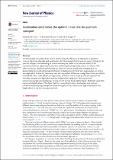Files in this item
Localisation determines the optimal noise rate for quantum transport
Item metadata
| dc.contributor.author | Coates, Alexandre R | |
| dc.contributor.author | Lovett, Brendon W | |
| dc.contributor.author | Gauger, Erik M | |
| dc.date.accessioned | 2021-12-23T16:30:03Z | |
| dc.date.available | 2021-12-23T16:30:03Z | |
| dc.date.issued | 2021-12-08 | |
| dc.identifier | 277028357 | |
| dc.identifier | c714e72e-0fc6-4c54-82dc-87f9547764b2 | |
| dc.identifier | 000728526100001 | |
| dc.identifier | 85122534024 | |
| dc.identifier.citation | Coates , A R , Lovett , B W & Gauger , E M 2021 , ' Localisation determines the optimal noise rate for quantum transport ' , New Journal of Physics , vol. 23 , no. 12 , 123014 . https://doi.org/10.1088/1367-2630/ac3b2c | en |
| dc.identifier.issn | 1367-2630 | |
| dc.identifier.other | Jisc: dadf611d414a48868ebfb7770747b72d | |
| dc.identifier.other | publisher-id: njpac3b2c | |
| dc.identifier.other | manuscript: ac3b2c | |
| dc.identifier.other | other: njp-113748.r1 | |
| dc.identifier.other | ORCID: /0000-0001-5142-9585/work/104619032 | |
| dc.identifier.uri | https://hdl.handle.net/10023/24577 | |
| dc.description | This work was supported by EPSRC Grant No. EP/L015110/1. | en |
| dc.description.abstract | Environmental noise plays a key role in determining the efficiency of transport in quantum systems. However, disorder and localisation alter the impact of such noise on energy transport. To provide a deeper understanding of this relationship we perform a systematic study of the connection between eigenstate localisation and the optimal dephasing rate in 1D chains. The effects of energy gradients and disorder on chains of various lengths are evaluated and we demonstrate how optimal transport efficiency is determined by both size-independent, as well as size-dependent factors. By discussing how size-dependent influences emerge from finite size effects we establish when these effects are suppressed, and show that a simple power law captures the interplay between size-dependent and size-independent responses. Moving beyond phenomenological pure dephasing, we implement a finite temperature Bloch–Redfield model that captures detailed balance. We show that the relationship between localisation and optimal environmental coupling strength continues to apply at intermediate and high temperature but breaks down in the low temperature limit. | |
| dc.format.extent | 14 | |
| dc.format.extent | 3735695 | |
| dc.language.iso | eng | |
| dc.relation.ispartof | New Journal of Physics | en |
| dc.subject | Noise-assisted quantum transport | en |
| dc.subject | Localisation | en |
| dc.subject | Disorder | en |
| dc.subject | Open quantum systems | en |
| dc.subject | Quantum transport | en |
| dc.subject | QC Physics | en |
| dc.subject | TK Electrical engineering. Electronics Nuclear engineering | en |
| dc.subject | NDAS | en |
| dc.subject.lcc | QC | en |
| dc.subject.lcc | TK | en |
| dc.title | Localisation determines the optimal noise rate for quantum transport | en |
| dc.type | Journal article | en |
| dc.contributor.sponsor | EPSRC | en |
| dc.contributor.institution | University of St Andrews. School of Physics and Astronomy | en |
| dc.contributor.institution | University of St Andrews. Centre for Designer Quantum Materials | en |
| dc.contributor.institution | University of St Andrews. Condensed Matter Physics | en |
| dc.identifier.doi | https://doi.org/10.1088/1367-2630/ac3b2c | |
| dc.description.status | Peer reviewed | en |
| dc.identifier.grantnumber | EP/L015110/1 | en |
This item appears in the following Collection(s)
Items in the St Andrews Research Repository are protected by copyright, with all rights reserved, unless otherwise indicated.

